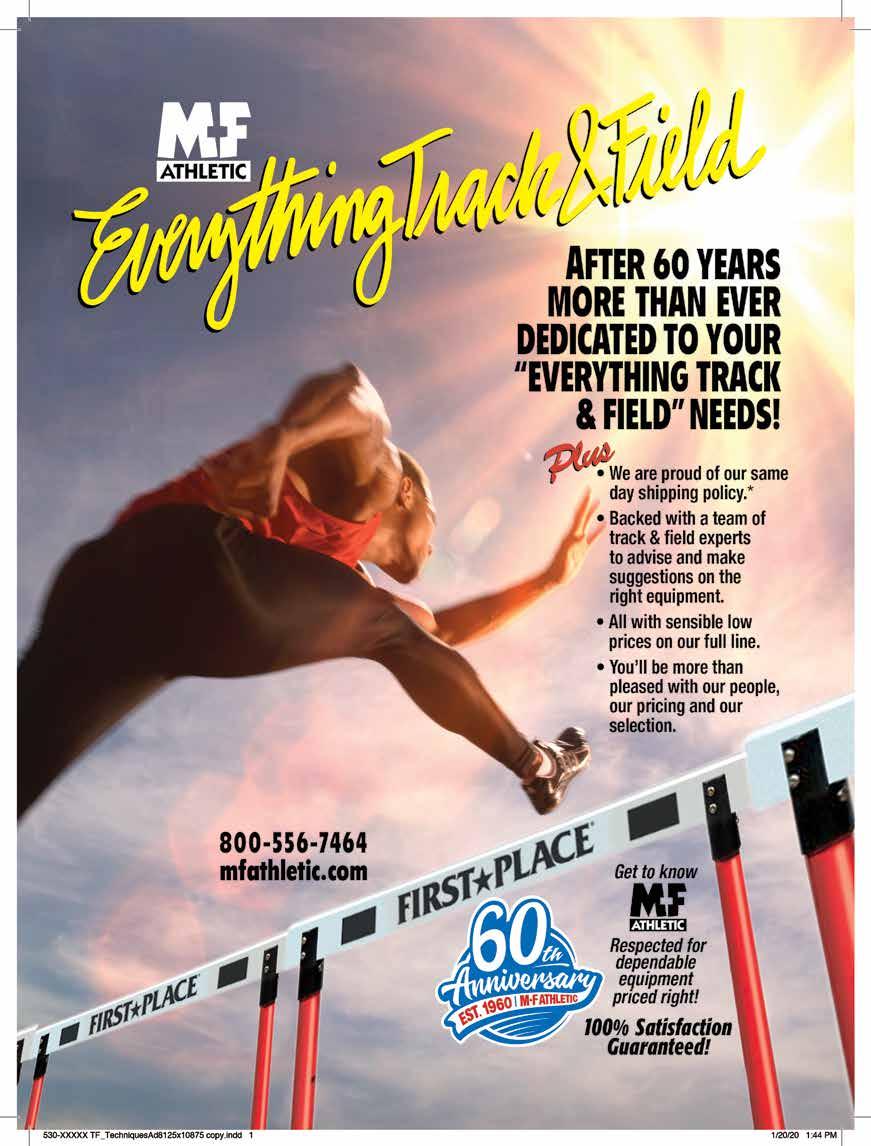
25 minute read
Discus Throwing
Multi-disciplinary mechanical applications
Discus throwing, as all the other throwing events, is, from a physical point of view, a multi discipline event. The discus throwing action is a combination of:
Jumping Ability, for the explosive action of the legs during the whole duration of the throw and particularly during the final phase,
Sprinting Ability, for the smooth and quick motion across the circle; and finally,
Throwing Ability, for the coordinated, efficient and effective application of the greatest force possible on the discus during the final phase.
Modern discus throwing technique is a result of both current scientific and empirical knowledge. This is expressed by a thorough knowledge of the human nature and the physical laws that govern the human movements. Briefly, the technique of discus throwing must be in accordance with: 1. The physiological, kinesiological and biomechanical laws that govern the human movement, 2. The movement pattern according to which the execution of the action takes place, and 3. The individuality of the athlete.
Discus throwing must be in accordance with the aerodynamic laws that determine the behavior of the discus when it is in the air (for more, see Maheras, 2021). A movement is effective when its execution takes place according to its specifications, i.e., the physiological and physical laws that govern it.
By using the proper technique, the discus throwers are enabled to transfer all or a great part of their power on the implement. This occurs because they take advantage of the laws that govern the body movements, thus increasing the work they can produce during a given moment (competition). Finally, the success of the thrower’s effort depends upon the expert coordination and use of the socalled internal and external forces which are present during the execution of the action by the discus throwers when they attempt to throw the discus as far as possible.
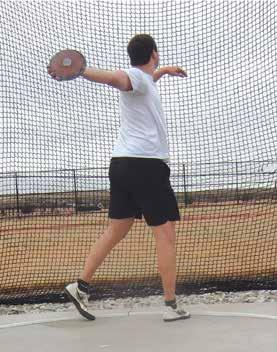
FIGURE 1. THE “WOUND UP” POSITION. FIGURE 2. THE TRANSITION FROM THE BACK TO THE MIDDLE OF THE RING, DURING FIRST DOUBLE SUPPORT (A), DURING SINGLE SUPPORT (B, C) AND (D) BEGINNING OF THE SECOND DOUBLE SUPPORT.

BASIC PHASES IN DISCUS THROWING Preliminary Wind (s)
During this part of the action, the thrower executes some preliminary winds, moving the discus and the body from right to left while, in essence, the thrower remains static. By doing this the thrower: • Overcomes the inertia of the ‘athlete - implement’ system by giving an initial velocity to both the discus and their body. This initial velocity, or else ‘the overcoming of the inertia’, allows the thrower to execute with greater ease the rest of the action. • Gives the discus a motion pattern. In essence, the thrower determines the plane and the direction of the motion which is about to occur.
The “Wound Up” position
During this phase (fig. 1), towards the end of their preliminary swings, the discus thrower rotates as far to the right and back as feasible. Apart from producing some stretching of the muscles, the main goal of this position is to provide more time for the subsequent counterclockwise motion through an increased counterclockwise range of motion. This time increase has to do with how angular momentum is generated in the back of the ring, the mechanics of which will be presented in detail in a future report by this author. Another goal of this position is to properly connect these preliminary winds with the rest of the action (timing and movement accuracy).
Transition
The discus thrower moves in a rotational fashion towards the center of the circle and generally toward the direction of the throw (fig. 2). This is accomplished by initially using two, and later one point, of support and rotation. This phase takes place from the moment the thrower is in the “wound up” position until the moment when the right foot reaches the center of the circle. During this phase, the discus thrower creates momentum. In fact, this is basically the only opportunity the thrower may have to develop the great majority of angular momentum for the rest of the throw, and therefore, this phase is of major importance for the outcome of the whole throw. More specifically, the thrower develops both linear and angular velocity, and consequently linear and angular momentum. “The thrower’s ability to generate a large amount of torque over a longer period of time in the back of the circle, is mostly responsible for the generation of that momentum”.
Power Position
The discus thrower comes in contact with the ground quickly and in balance, by landing on the feet successively, first on the right and then on the left, while allowing a certain distance between them (fig. 3). By doing this, the thrower ensures a stable base of support which will allow for the application of force. Moreover, with the left leg, a blocking point is created, which in turn creates the prerequisites for an even greater acceleration of the already increased rhythm of the motion of the discus.
Release
Here (fig. 4), the discus thrower leads the discus to the highest point of its release, while simultaneously applying the maximum force possible on it by summing up all the secondary forces into one, thus imparting a greater velocity at the time of release. Another characteristic of this phase is the development of vertical velocity.
MECHANICAL AND KINESIOLOGICAL APPLICATIONS Preliminary Wind (s)
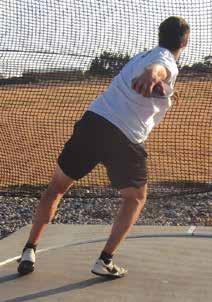
FIGURE 3. THE POWER POSITION. FIGURE 4. THE RELEASE. FIGURE 5. FIRST DOUBLE SUPPORT.

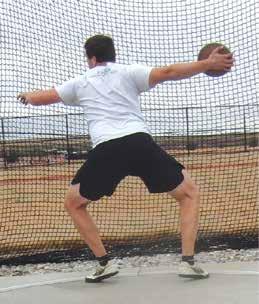
Inertia is the force/reaction that is presented when another force tends to alter its state of motion. Thus, when a body is at rest, there is a certain resistance to put it into motion, while if it is already in motion, it tends to remain in motion. The inertia that a body presents is proportional to its mass. The heavier the body, the more difficult it is to move or else, the more difficult it is to alter its speed. The discus thrower, by making use of this principle, does not initiate the effort from a static position, but to the contrary, an attempt is made to impart a certain speed to the body + implement system, for an effective execution of the rest of the movements.
The “Wound Up” position
Keeping in mind the axiom which states that when activities in which two or more movements are executed towards a given direction, in order to maximize their effectiveness, no pause must occur during their execution, the completion of the first movement overcomes a great amount of the inertia of the body; thus, the work of its successive movement becomes progressively easier and efficient. Every interruption that may occur will result in the loss of part or the whole advantage that was gained from the previous movements. Therefore, the discus thrower must smoothly connect the preliminary winds with the ensuing throwing action, lest there is a loss in the gained advantage from the previous phase, when the inertia of the discus as well as the body was initially overcome. In addition, as mentioned earlier, as far as the thrower’s effort to rotate to the right is concerned, it must be pointed out that this has to do with the application of force (or better stated, torque), as well as the movement of the pertinent limbs, through the greatest time possible. The advantages of this effort will be presented in a future report.
Transition First Double Support
The lower the center of gravity, whether the body is in motion or static, the better one can maintain their balance (fig. 5). Moreover, it is known that the more the muscle is stretched (up to an optimal point) the more energy it can store, which results to a greater force production. Taking advantage of these principles, the discus thrower during this phase, flexes the knees which implies that there is a stretch in the muscles of the thigh, while at the same time there is a lowering of the center of gravity, to enhance balance.
Single Support
During this phase (fig. 6) the discus thrower initially is supported only by the left foot/leg with the right leg widely spread to the right. The right arm is back in a rather straight line, while the left arm moves fairly straight to the left. Exactly at this point, this particular position of the thrower constitutes a system, parts of which are located away from the main axis of rotation, which means that the moment of inertia is greatly increased.
Airborne Phase / Conservation of Angular Momentum
After the thrower has already developed a certain velocity and has transitioned, pivoting over the left foot, and while being airborne, quickly brings, a) the left leg close to the right and, b) “wraps” the left arm more or less in front of the chest, both closer to the center of rotation, thus increasing the angular velocity (fig. 7). In essence, the thrower makes use of the principle concerning the conservation of the angular momentum which states that: ‘providing that no force is exerted upon a body, the latter either remains static or rotates with a constant velocity.’ The discus thrower is initially in an “open” position (fig. 6), which is characterized by a well developed moment of inertia, whereas later the thrower suddenly ‘closes’ (fig. 7), and in order to maintain the angular momentum constant (conserved), the angular velocity is increased,
Because: G = I ω
Where: G = angular momentum I = moment of inertia ω = angular velocity
The same principle is used by dancers and gymnasts in their routines. Moreover, during this phase, the discus thrower makes an effort to maintain the torso neutral, whereas purposely giving the priority to the feet/legs. This enables the
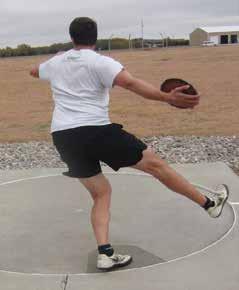
FIGURE 6. FIRST SINGLE SUPPORT. FIGURE 7. AIRBORNE PHASE. FIGURE 8. THE RESULTANT FORCES R AND R”.


thrower: • To have the most effective position during the final power position, • To take advantage of the forces generated from the legs, and • To ensure a valid throw
Moving towards the center of the circle constitutes the fundamental phase for linear momentum development and rotational momentum “storage” during the transition phase. The discus thrower develops momentum because the body as a whole moves with a given speed, thus,
Because: J = m v where: J = momentum (linear) m = body mass v = body velocity
The amount of momentum will be equal and proportional to thrower’s mass (weight) and the velocity of their motion.
Note: Although mass and weight are not one and the same thing, (mass is the measure of the inertia of an object, while weight is the force with which the earth pulls it); here, for convenience purposes their meaning has been considered the same because under earth conditions their difference is minimal (compared, for example, with the conditions that are prevalent on the moon surface).
Finally, because: F = m a where:F = force
m = mass a = acceleration and: a= v/t where: a = acceleration v=velocity t= time therefore: F = m v/t which finally comes to: F = J/t which shows that force production is proportional to mass, and as mass increases, force also increases. Moreover, this phase does not take place by covering a short distance through the ring, but to the contrary, there is an effort to cover a nominal distance within the circle. This, because, not only the work produced by the thrower’s body is greater,
Since: W= F s where:W= work F = force s = distance but also the developed moments are greater, Because: J = m v, and v = s/t which shows that momentum is proportional to the distance covered providing that the time allotted is a fixed value.
Note: It has been found that rotary momentum, both about the vertical and the horizontal axis, is the main contributor to the discus speed (Dapena, 1993). Therefore, attention must be paid on the rotational aspects of discus throwing rather on the translational.
Linear Direction
The discus thrower moves linearly on the axis of direction. This means that, essentially, an attempt is made to sum up the forces toward a straight line, making use of the principle which states: ‘when two or more forces act on a body, or two or more forces act toward each other, the resulting motion is determined from their direction and their magnitude.’ More specifically, Newton said that these two forces can be combined into just one force, called the resultant force that would have the same effect on the body as the two forces did individually. To find the resultant, one would make a parallelogram with the sides equal to the two applied forces. The diagonal of this parallelogram will then be equal to the resultant force. This is called the parallelogram of forces law. This way, the total force expressed with the velocity of release, constitutes the resultant force of all the secondary forces which were developed by the thrower toward one and only direction.
Figure 8, shows that while the forces F1 and F2 have the same magnitude, in the first case (the angle formed is relatively small) the resultant R has greater value than the resultant R” (the angle formed is relatively large). The forces then must tend to have a linear relationship to each other rather than to diverge (for more see Maheras, 2012).
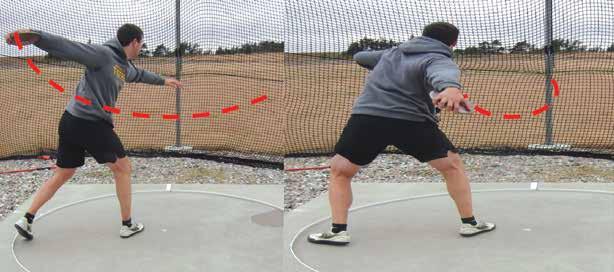
FIGURE 9. OPTIMAL PATH OF ACCELERATION (LEFT), COMPARED WITH A POOR ONE (RIGHT).
Second Double Support Phase
The discus thrower arrives in the power position (both feet are in contact with the ground) by bringing in contact first the right foot and then the left. At this moment, 1. The thrower brings the feet actively and smoothly in contact with the ground by landing on the ball of the feet to support the body. One can compare the action of the feet, and particularly of the right one, to a spring, which is initially suppressed as it absorbs the sudden load (the thrower’s body weight) as the thrower comes in contact with the ground with their right foot (elastic landing). 2. Immediately after this, the muscle which is now stretched, actively reacts and returns the stored energy (reactive landing). If to the contrary this won’t occur and the thrower either comes in contact with the ground by using the whole foot or fails to react, then according to the kinesiological principle already mentioned, there will be a loss of part or the whole advantage of the momentum gained from the previous actions. 3. The discus thrower quickly brings the left foot in contact with the ground immediately after the right foot landing. This is done, in part, to avoid a premature rotation and translation of the upper body to the left and front, a rotation which is otherwise caused by the already acquired momentum, a fact that has as a consequence a decrease of the path through which the thrower can apply force. In other words, the thrower, during this phase, strives to be in a rotating position toward the right and back, thus increasing the distance through which force can be applied, taking advantage of this action (fig. 9). More specifically,
The work that the thrower produces (W) is equal to the force (F) applied, times the distance (s) through which that force is applied.
That is: W= F s which means that the more powerful the thrower and the greater the distance through which the force is applied, the greater the work produced. A caveat here, however, is that the distance must be covered in the least time possible. If one increases the distance through which the force is applied, they must maintain constant the time in which this distance is covered when compared to another shorter distance. Otherwise there is no real benefit from this relationship. because: P = W/t which means that the work done, in essence represents the power of the thrower, must be done in the least time possible. Moreover, keeping in mind the equation about work, one can reframe the power equation to:
P = F s/t but F = m a and: a= v/t which means that: F = m v/t which finally comes to: F t = m v
This relationship shows that the greater the force, the greater the velocity, and the greater the time of the force application, the greater also the velocity. This last statement comes in conflict with what was mentioned earlier regarding the application of the force at the least time possible to achieve the greatest velocity at the moment of release. Pertaining to this, one should have in mind that the above statement is indeed valid when the distance of force application is indefinite. In the case of discus throwing, however, this distance is finite (s = a fixed value) so the relationship above (F t = m v) ,
turns into: Ft = m s/t
So, F t2 = m s, and because, m s = constant (a fixed value) (m = mass of the discus and s = distance of force application)
Then, F t2= a fixed value
which means that as the force increases, the time decreases (and the reverse). The thrower, therefore, indeed wishes to apply the greatest force in the least time possible.
The contact of the feet with the ground does not take place simultaneously, because a break in the motion will occur which will have a negative effect in the whole action due to the principle already mentioned earlier. Therefore, the feet are planted quickly and in succession. In this way, the time between the feet landing tends to approach zero, but it never does. Moreover, for a very short period
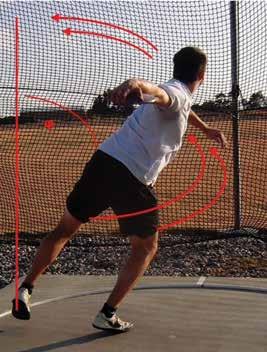
FIGURE 10. COORDINATED TURNING AND PUSHING ACTION OF THE RIGHT SIDE DURING DELIVERY (Φ = ATTACK ANGLE).
of time, the bodyweight is entirely over the right leg. Thus, the discus thrower not only takes advantage of the increased distance through which force is applied, but also an increase in the ‘attack’ angle (fig. 10). By transferring the body weight from the back leg (right) to the front (left), the thrower manages to pass through the phase of the ‘stretched bow’, and to lead the discus to the highest point of release.
Release
During this phase, the thrower essentially transfers the stored rotary momentum from the body to the implement. The body weight is transferred from the back leg (right) to the front (left), while at the same time an attempt is made to drive the right lower side (fig. 10). Beyond the already mentioned results of this kind of movement (from back to front), and in combination with the proper placement of the left leg next to the rim, the discus thrower: a. Restrains the body’s horizontal velocity and converts it to rotational in a vertical plane around the point of support of the left leg, and b. Rotates the body in a horizontal plane around a vertical axis, whereas the distance between the two legs, as well as their degree of bending, must be in accordance with the principle of the ideal distance which states: ‘it (the ideal distance) should be so large or so small so as to give the best results, particularly when compared with other positions with greater or smaller angles of bending.’
Likewise, the degree of momentum that the discus thrower makes use to be able to throw their discus as far as possible, should be personal for each thrower, to be able to supply their forces constantly on the implement with an even increasing acceleration.
More specifically, with the placement of the left foot next to the rim, the discus thrower is able to: 1. To apply force, exactly because the left foot presents a reaction which the discus thrower is called to overcome, 2. To rotate around the vertical axis by using as a point of rotation the point of support of the left leg down the circle and radius of rotation their height, a fact that enables them to develop a small amount of additional angular momentum which has, as a result, the development of angular velocity (ω) (omega) and, because: G= I ω where:G= angular momentum I = moment of inertia, ω = angular velocity and: v = ω r where:v = linear velocity ω = angular velocity r = radius
then, the higher the angular velocity, the higher the linear.
Based on the axiom which states that every body maintains its velocity constant, providing that the resultant force of the forces acting upon it equals zero, this reactive action of the left foot (which hampers the already developed velocity) favors the thrower who, because of the inertia the rest of their body presents, both has a tendency to move fast to the front and also plant the left foot rapidly (for more on the left foot action, see Maheras, 2009).
Concerning the rotation around the vertical axis, one can observe that because the linear velocity of a rotating body is proportional to the distance from its axis of rotation, it is evident that their shoulders and their right arm have the greatest velocity because their distance from the axis of rotation, which is the left foot, is greater than that of the other body parts (e.g., hips). Moreover, the discus thrower during this phase attempts to: 1. Thrust the right lower side to the front while leaving the throwing arm inert. This is done to take advantage of the stretch or myotatic reflex, which occurs on the muscles around the waist area and chest due to the sudden stretch resulting from the torsion between the axes of the hips and the shoulders. 2. Cross the axes of the hips and shoulders, which is a product of the previous action. This rotation of the body around its vertical axis throughout the duration of the action has as a result the lengthening of the distance through which force is applied during the final phase of release. 3. Push the legs rapidly and actively against the ground to take advantage of the law which states that ‘when a body ‘A’ exerts a force to another body ‘B’, then the body called ‘B’ exerts another force which is equal and opposite to the first.’
The thrower applies as much force as possible against the ground and the later reacts by ‘returning’ it.
Note: Discus throwers may think that are exerting forces against the ground during the delivery phase, but they are mostly not (Dapena, 1994). However, although the thrower exerts minimal forces against the ground during the delivery phase, these
forces are not zero. 4. Apply force with a proper sequence, timing and rhythm to avoid any break in the generation of the secondary forces that have been developed up to a given point of the whole action. This way, every lever/joint activated according to the movement pattern is able to transfer to the implement an increasingly accelerated movement toward a given direction. The faster the levers succeeding each other, the better the thrower’s potential. Moreover, the aforementioned movement coordination has an energy saving effect as far as the thrower’s energy storage. By maintaining a constant movement pattern, the discus thrower applies force smoothly without interruptions. If interruptions occur, they will automatically force the thrower to begin their effort from an almost inert state, having lost an important amount of energy to succeed in the work which has already been done until the moment of the interruption. Prerequisite, however, for such a coordinated action, is the total participation of the discus thrower’s body levers. This is done, in the first place, by activating the big and powerful muscles which are relatively slow and surround joints that have rather restricted flexibility, while subsequently activating the small and less powerful muscles which are rather fast and surround joints of greater flexibility. 5. The thrower progressively stabilizes the body levers/joints from down up and from left to right, so as each following lever/joint when its turn comes to be activated, is able to have as a point of support the previous lever/joint which has already concluded its action and now serves as the supporting point of the next joint/lever. This results in a thorough utilization of the whole body’s potential. Eventually, the whole left part of the thrower’s body abruptly stops as the left arm blocks. By doing so, the thrower is enabled to transfer momentum from the left arm to the right arm. What happens is that the body segments of the right side, and particularly the right arm, move forward with a velocity which is more than double the speed that the body had until that time. One can compare this successive stoppage of the different body parts to the waves that approach the coast one after the other without pause, or a series of dominoes which drop one after the other.
1. The Thrower’s Body Weight.
The weight of a thrower will affect the angular momentum (G) that they can generate while they are moving across the circle, because it is equal to the moment of inertia (I) which is the body mass, times the angular velocity (ω) (omega),
That is, G = l ω
The generation of greater angular momentum will potentially enable the thrower to transfer a greater amount of that momentum to the implement during the delivery phase.
2. The Thrower’s Strength.
Because: F = m a which means that the acceleration that a body develops is proportional to the force which is applied upon it, one can conclude that the stronger the thrower, the more the force that can be exerted on their implement, which means that the acceleration is greater, which in turn results to a greater velocity of release.
Note: By far, the most important factor for an increased distance thrown is the velocity of release. Mathematically, for example, in the relationship below which is used to calculate the range of a projectile, the velocity (v) of release is squared, showing its paramount contribution in the maximum range of a projectile.
R = v2sin(2ω)/g
3. The Thrower’s Height
The taller thrower has an advantage because, finally, they release their discus from a higher point and thus, if we consider that the angle and velocity of release to be the same between two throwers, the higher the point of release, the greater the distance thrown.
Note: By far, height of release is the least factor affecting distance thrown.
4. The Thrower’s Arm Span
A thrower with long arms has a certain advantage over the thrower with short arms, and this is because: v = ω (omega) r which means that the linear velocity (v) that every point of the circle which the thrower “draws” while they are moving equals to the angular velocity (ω) times the radius of rotation (r) which in the case of the discus thrower is their arm.
So by considering that the angular velocity is the same between throwers, the longer the thrower’s arms (the radius of
5. Finally, generally, the bigger the thrower the better
As far as height is concerned, because every body lever ‘draws’ bigger circles or arcs of a circle, a fact that shows that during the same time period, the bigger thrower’s limbs cover longer paths, and at the same time generate greater momentum, be it linear or rotary. It is interesting to note here that the movements of the human body parts are similar to those of the levers which are rotational/angular.
A general note: When one examines the various physical properties (body weight, body height, strength, etc.) between two throwers, in order to decide who has the advantage over the other, it must be kept in mind that we have to examine only the property/ability under consideration, while we consider that hypothetically all the other abilities of the throwers are the same. Only under those circumstances can what was mentioned be true. In any other case, a short thrower might be better than a taller one, for example, because the former is stronger or faster, etc.
ADDENDUM:
In memory of Petros Papageorgiou, coach, professor and mentor, 1926 - 2020.
REFERENCES
Maheras, A. (2021). Basic Aerodynamics and Flight Characteristics in Discus Throwing. Techniques for Track and Field & Cross Country, 15 (2), 4-12.
Maheras, A. (2012). The Horizontal Translation in Discus Throwing. Techniques for Track and Field & Cross Country, 5 (4), 33-36.
Maheras, A. (2009). Pros & Cons. The Grounded Release Method Versus the Airborne Release Method in the Discus Throw. Techniques for Track and Field & Cross Country, 3 (2), 38-42.
Dapena, J. (1994). New insights on discus throwing: A response to Jan Vrabel’s comments. Track Technique, 129, 41164119.
Dapena, J. (1993). New insights on discus throwing. Track Technique, 125, 39773983.
DR. ANDREAS MAHERAS IS THE THROWS COACH AT FORT HAYS STATE UNIVERSITY AND IS A FREQUENT CONTRIBUTOR TO TECHNIQUES.


USTFCCCA Supporters
Through their ongoing support of the U.S. Track & Field and Cross Country Coaches Association, these companies demonstrate their strong commitment to the sports of Track & Field and Cross Country. The USTFCCCA strongly encourages each member to purchase products and services from these supporters.

mondoworldwide.com

sportsbyapt.com/sport/track connect.marines.com


beynonsports.com
directathletics.com
ucsspirit.com
simplifaster.com


mfathletic.com geosurfaces.com balfour.com

maxmedals.com
gillporter.com

ucsspirit.com
surfaceco.com



coachesdirectory.com vsathletics.com
